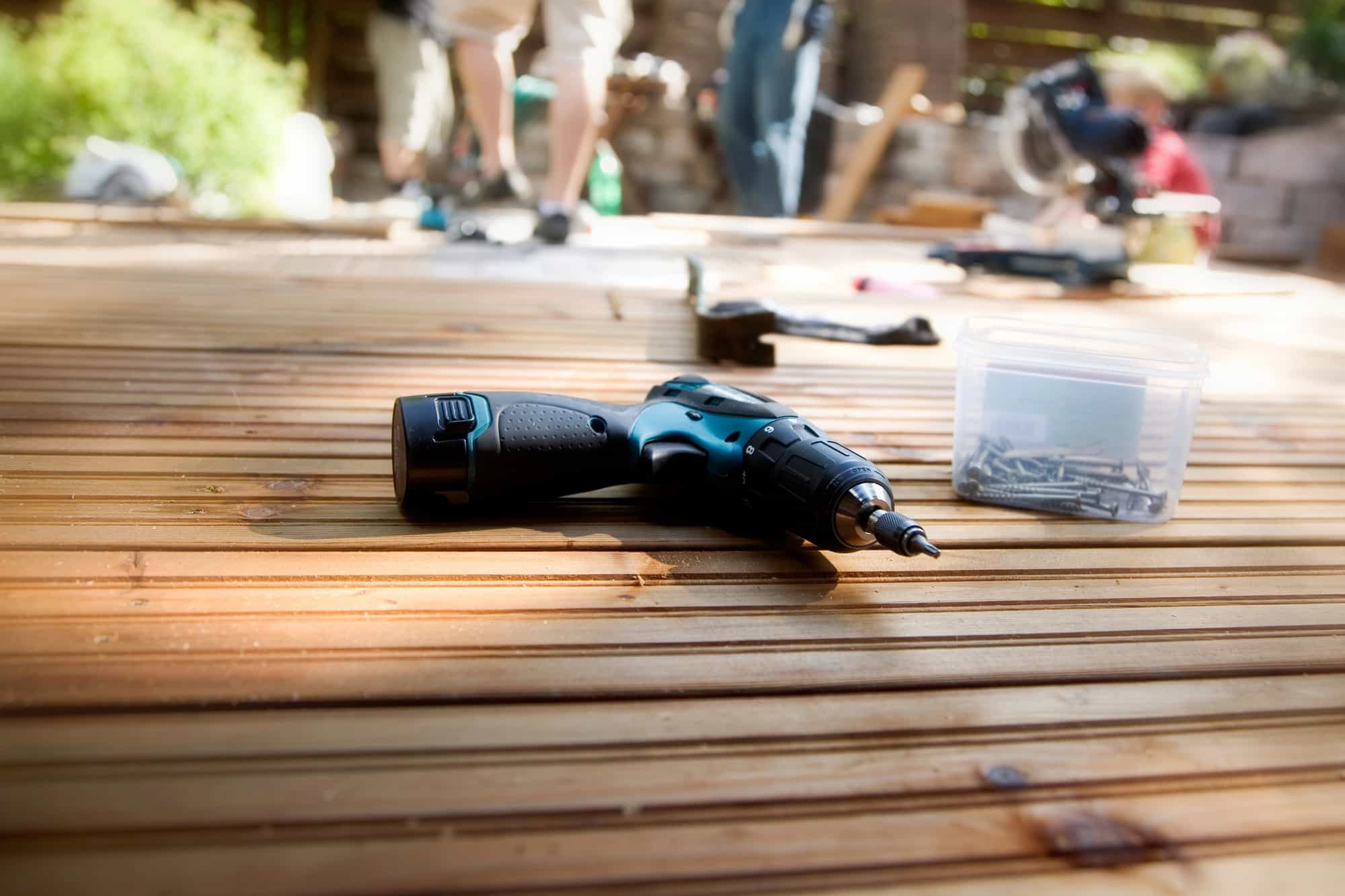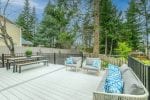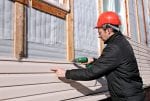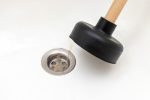5 signs your deck boards need replacing
When should you change your deck board and how do you detect that it needs replacement? First of all, you need to do regular inspections to help you catch the small problems before they become big headaches.
For instance, if you notice a wobble beneath your feet or splintered boards that snag your socks, then you have to do something about it before it leads to accidents.
You may assume that a loose railing or rotting support beam is a minor issue, but they can cause serious injuries or even collapse under pressure.
Moreover, the more you neglect deck maintenance, the more costly it will be. You will surely get frustrated when you are forced to replace an entire section of your deck just because you didn’t catch the rot in time.
5 signs your deck boards need replacing
- Visible Damage
- Rot and Decay
- Loose Boards and Squeaking
- Insect Infestation
- Water Damage and Staining
Visible Damage
These are damages that are easy to discover. Examples include cracks, splits, warping, and splintering on the deck. Splintering can cause painful injuries, especially for kids and pets who might not watch where they step.
Cracks and splits weaken the structure, which makes it prone to collapse under weight or pressure. Warping can cause uneven surfaces, likely causing trips and falls.
The above issues stem from weather exposure, like rain, snow, and sunlight, which can wear down wood over time.
Older decks are continuously more susceptible to damage and improper installation, such as using low-quality materials or not allowing enough space for expansion and contraction, which can exacerbate these problems.
Choosing quality composite decking products can solve these issues, as they are less susceptible to moisture damage, warping, splintering and pest attacks.

Rot and Decay
Rotted wood lacks the strength to support weight and can crumble unexpectedly, putting anyone on or near the deck in danger. Rot is not always easy to notice, but soft spots, discolouration, and fungal growth are telltale signs.
An example of a soft spot is when a seemingly sturdy beam gives way like a sponge. Discolouration, such as dark patches or a greyish hue, suggests moisture damage, which can lead to rot over time.
Fungal growth, like mildew, often accompanies rot, appearing as black or greenish spots on the wood. To test for rot, probe suspect areas with a screwdriver. If the wood feels soft or crumbles easily, it is likely rotted.
Do not apply excessive pressure, as severely rotted wood may give way suddenly. If you notice that it is rotting, take your head to promptly repair it and constantly inspect it to ensure the safety of your deck.
Loose Boards and Squeaking
Loose boards create instability and increase the risk of trips and falls, especially for children and elderly people. Squeaking boards are another warning sign of trouble.
Squeaking often indicates underlying structural issues or fastener failure, meaning that the nails or screws holding the boards in place are coming loose. This compromises the stability of the entire deck and, if not addressed, will likely collapse.
Continuously, weather, wear-and-tear and improper installation are common causes of loose deck boards. Improper installation, such as using insufficient nails or screws, can also contribute to boards coming loose over time.
Regular inspections and timely repairs can help prevent accidents and ensure your deck remains safe and sturdy this season.


Insect Infestation
Sawdust is usually a telltale sign of these pests burrowing into the wood to create nests and tunnels. When you tap on a seemingly solid beam and hear a hollow sound, it signifies that the voracious insects have hollowed the insides out.
Termites and carpenter ants chew through wood, thus compromising its strength and stability. As these pests continue to feed and multiply, the damage to your deck can escalate quickly, which can lead to costly repairs or even collapse.
If you suspect insect infestation, contact pest control professionals to assess the extent of the infestation and recommend appropriate treatment to eliminate the pests and protect your deck from further damage.
Water Damage and Staining
Standing water, warped boards, and excessive moisture can damage and stain your deck board. The standing water seeps into the wood, leading to rot and decay over time.
Warping not only detracts from the appearance of your deck but also compromises its structural stability. Excessive moisture creates an ideal environment for mould and mildew to thrive.
Mould is not only unpleasing to the eyes but also poses health risks, especially for those with respiratory issues. Proper drainage and ventilation are required to prevent these problems.
Adequate ventilation allows air to circulate, which helps to dry out moisture and reduce the risk of rot and mould growth.
When to Call a Professional
When the damage has become quite extensive, you have structural concerns, or you are uncertain about DIY repairs, then it may be time to consult a professional.
Professionals have the knowledge, experience, and specialized tools to assess the situation accurately and recommend the most effective solutions.
A professional inspection can uncover hidden problems that you may have overlooked. It also ensures thorough repairs and prevents safety hazards. Hiring professionals for inspection and repair is an investment that ensures your deck’s safety and saves you time, money and frustration in the long run.
In Summary
Detecting signs of deck board issues is not enough; prompt action is also important. Take proactive steps towards deck maintenance and safety. You can do it yourself or employ professionals to do the job for you.
![[AD] We went to the newly opened Cha Sha Kingston a couple of weeks ago, and wow — taste bud adventure unlocked! The boys devoured the masala fries and chicken tikka rolls, while we couldn’t get enough of that epic kebab butter curry 😍🍛.
It’s amazing value for food this tasty (and everyone left happy and VERY full!).
Delicious food, vibrant vibes and incredible value — the perfect combo for your next meal.
📍Cha Sha Kingston
43 Surbiton Road, KT1 2HG
🌐 chasha.co.uk
Other Cha Sha locations in Birmingham, Ilford, Southampton and Wembkey
#ChaSha #ChaShaKingston #KingstonEats #FoodieFinds #UKFoodie #FoodReview #KingstonUponThames #FamilyEats #FamilyDining #FoodieKids](https://suburban-mum.com/wp-content/uploads/2016/02/574770541_18560351146016840_6855048070839528040_n-180x320.jpg)

![[AD] We’re a cricket-mad family, so we’re buzzing that @thehundred is back this August! 🏏🔥
To get ready, M tried out the official FREE Activity Pack — and it’s brilliant! 🙌
Packed with fun games, creative challenges and sporty tasks, it’s perfect for getting kids hyped whether you’re at home or on the go.
👉Download yours now (link in bio)
@londonspirit @ovalinvincibles #EveryMomentCounts #TheHundred
#EnglandCricket #CricketFamily #TheHundredCricket #LondonBloggers #Cricket #CricketIsLife #kidsfun](https://suburban-mum.com/wp-content/uploads/2022/11/505472555_18531279601016840_7092520074819907569_n-180x320.jpg)



![[AD - Press visit]
We enjoyed the glorious sunshine this weekend with a trip to Brighton. We went on the @brightoni360official which is right by the sea front.
The i360 pod take a slow journey up, allowing you to take in views across Brighton and the South Downs 450ft above ground. There’s a bar inside with drinks and snacks available to purchase and the experience lasts 25 minutes.
Afterwards, we headed to the open air roller rink for a roller skating session!
The roller rink is:
⭐ Suitable for over 5s
⭐ £6.50 if you have your own skates or £9.50 if you need to hire them
⭐ 45 minutes per session
Full details to visit the i360 + skating
📍 Brighton i360, Lower Kings Road, Brighton BN1 2LN
🚗 Parking nearby (we parked in the Regency Square Car park)
🎟️ Prices start from £25.40 for an adult and £16.90 for a child
🕐 Opening hours are currently Sun-Fri 10.30am-18.30pm and until 19.30pm on Saturdays
☕️ Bar inside the i360, cafe and gift shop
Book tickets here:
https://tickets.brightoni360.co.uk/tickets/?_ga=2.195305772.1869001490.1689671753-1757164059.1689671753/#events?eventid=157](https://suburban-mum.com/wp-content/uploads/2015/04/417980235_313576471048632_3682382982231216432_n.jpg)

![[AD] ***Summer of fun at Barracudas Activity Camps!****
There is plenty for kids to do at @barracudas_activity_day_camps
From Tennis, Archery, Swimming, Motor Sports and more you can be sure that there will be something for kids aged 4.5-14. ⚽🏈🥅🎾🏓🏎️🏹🏊♂️🏉
You can book on a day by day basis - so it can fit in with any other days out/activities you have planned and there are early drop off and late pickup options available. Barracudas are also Ofsted registered so you can use your Childcare Vouchers too.
⭐⭐⭐Get £20 off a week or £4 off a day using my discount code: MARIA20⭐⭐⭐
#BarracudasActivityDayCamp #BarracudasActivityCamp #BarracudaAmbassadors #SummerHolidays #SchoolHolidays #Summer2023 #SummerCamp #DayCare #Camp #KidsCamp #surreymummy #surreymums #SummerOfFun #ActivityCamps #HolidayCamps #Childcare #SchoolHolidays #schoolholidaycamps](https://suburban-mum.com/wp-content/uploads/2024/07/353583570_625625966167953_545896259645102575_n.jpg)



![[AD] We have some super exciting news...we have been chosen to be Laser Quest Ambassadors, and the boys are over the moon!
We are really lucky that our local Laser Quest (@laserquestkingston) is just around the corner from us. It means we can pop in of a weekend or anytime during the school holidays, and with summer just around the corner, I know Laser Quest will be one of our go-to places for some family fun.
As well as games of Laser Quest, there are also VR experiences and arcade amusements too. To find out a bit more about how Laser Quest works, you can read my blog post: https://www.suburban-mum.com/laser-quest-kingston/ (clickable link in bio)
Don't forget to keep an eye out for our Laser Quest posts - I'm going to be giving away two family passes to use at Laserquest Kingston!
If you can't wait and want to head down to Laser Quest to try it out, use the code SUMMER30 for 30% off your booking. The code is valid from now until the end of August 2023 and can be used on Laser Quest games and birthday party bookings.
#LaserquestAmbassador #Laserquest #LaserquestKingston #ActivitiesForKids #FamilyFun #DaysOutWithKids #Lasertag #LaserquestVR #Kingston #ThingsToDoInKingston #SurreyFamilyDaysOut #ThingsToDoWithKids #RainyDayFun #SurreyMummy #SurreyLife #LifeWithKids #LifeWithBoys #familyfunday](https://suburban-mum.com/wp-content/uploads/2015/04/353230107_797358078406942_2405522556733455165_n.jpg)

![[AD] The sun has finally made an appearance and the boys have been making the most of it by spending it
in the garden.
They’re go-to is always football and they’ve been trying to improve their aim and accuracy with the new Messi Foldable Footlball goal from the #MessiTrainingSystem range.
I love the fact the goal is foldable, making it easy to store away when not in use. It is also lightweight so you can effortlessly pack it up and take it to the park or to a friend’s house.
The Messi Foldable Football Goal retails at £36 and can be purchased from @argos
You can read my full review here: https://www.suburban-mum.com/messi-foldable-football-goal/
#TrainLikeMessi #FoldableFootballGoal #FootballSkills #OutdoorFun #LionelMessi #LeoMessi #FootballAtHome #OutdoorKids #JustGetOutside #OutdoorsAndFree #ScreenFreeKids #WhateverTheWeatherKids @flair_gp](https://suburban-mum.com/wp-content/uploads/2015/04/341194882_615024710178056_41977149395989448_n.jpg)

![[AD] We are absolutely thrilled to announce that we are Barracuda Ambassadors again this year.
With Easter just around the corner, the boys were sent the @barracudas_activity_day_camps new camp kit in preparation for the school holidays.
There’s a wide range of activities for kids aged 4.5 - 14 including Tennis, Archery, Basketball, Arts & Crafts and more.
If you like the sound of Barracudas, find out more over on their website. You can also save £20 a week or £4 a day, using my discount code: MARIA20](https://suburban-mum.com/wp-content/uploads/2024/07/336812306_765234558514317_685553691647241974_n.jpg)


![[AD - Gifted]
Last weekend we were invited to try out @tsarettaspice’s new Bottomless Brunch menu and I can tell you it was thumbs up all round!
There’s a good choice tapas on offer from Punjabi fish fingers, Indo Chinese Chicken to Spiced Lamb Scotch Eggs and Manchurian Cauliflower (which was amazing!)
If you’re local to Twickenham and fancy giving them a try here’s are the details.
Tsaretta Spice Bottomless Brunch
⭐️£37.50 per head for bottomless Prosecco or cocktail of the day
⭐️£55 per head for bottomless Champagne
⭐️ Food included: 4 tapas selections and dessert or 2 tapas selections, a pav or naanwich and dessert
⭐️ Non-alcohol brunch is also available
Tsaretta Spice
55 Church Street
Twickenham
TW1 3NR
You can also read our full review over on the blog (link in bio)](https://suburban-mum.com/wp-content/uploads/2024/07/334565436_5960402314015030_663031098700829518_n.jpg)



